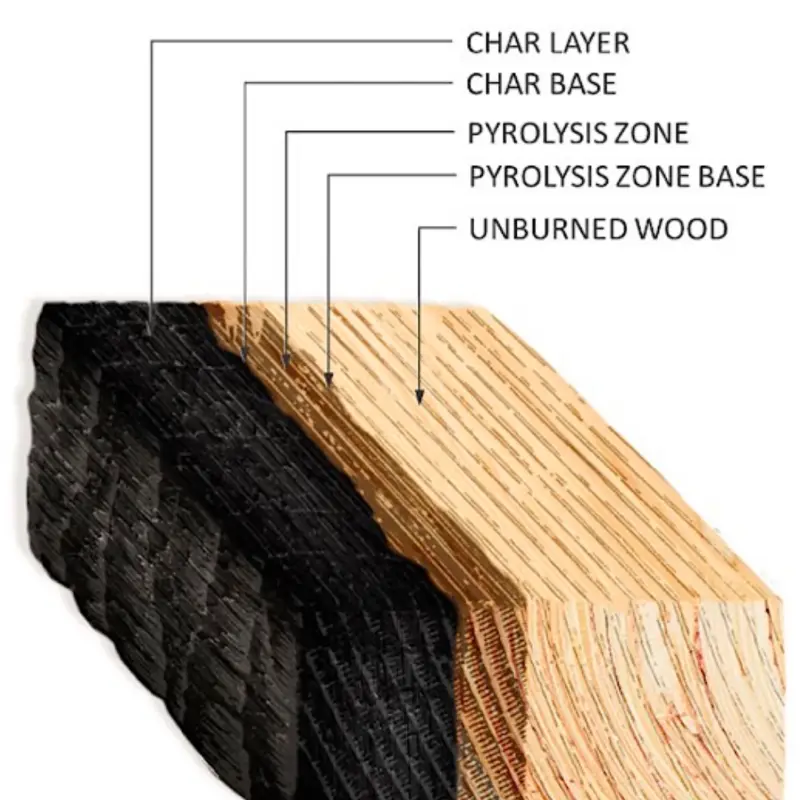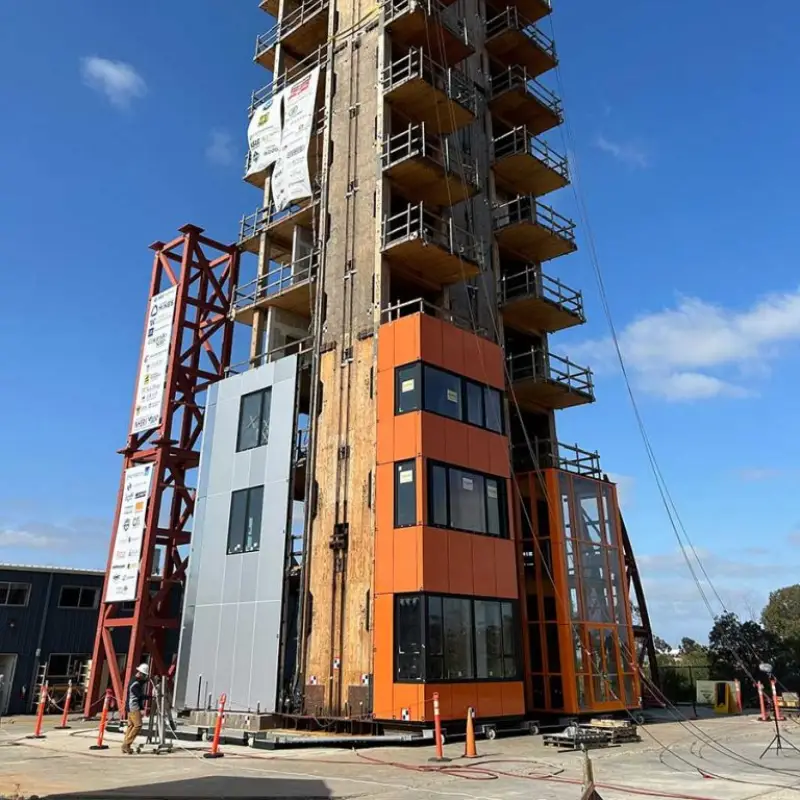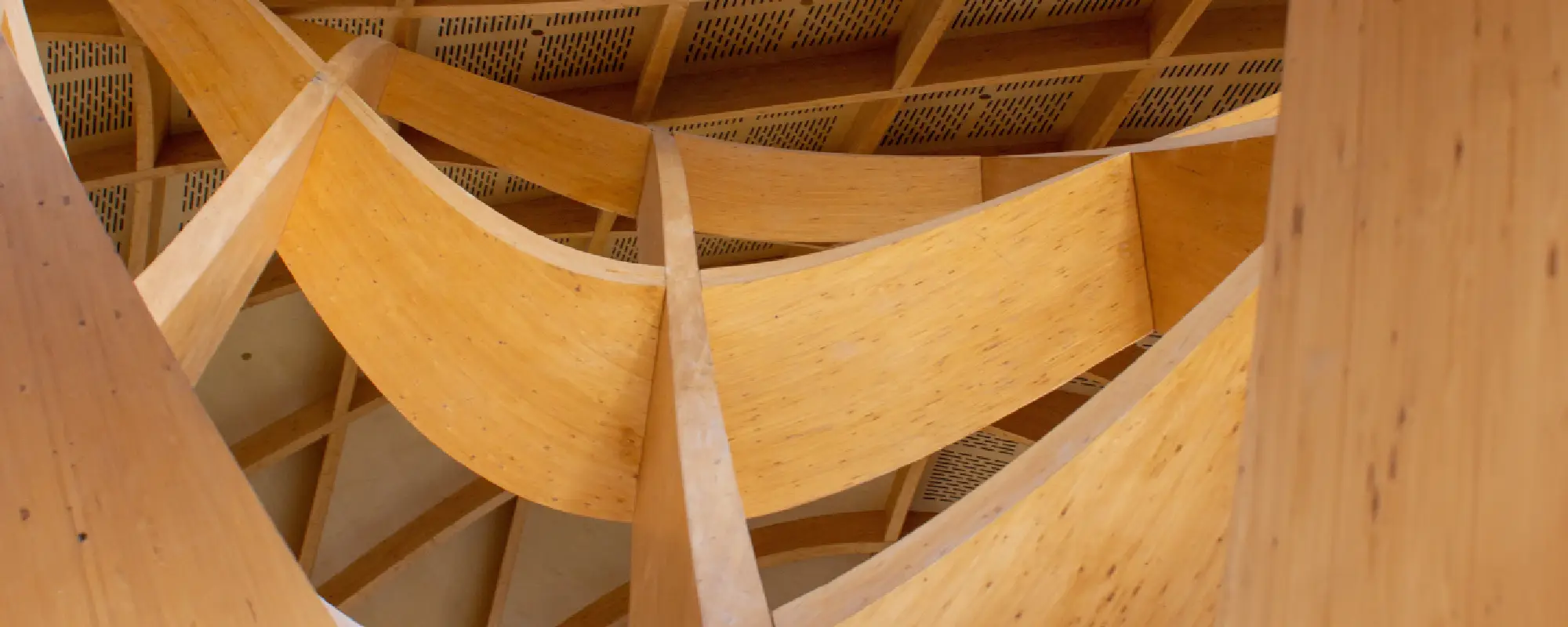Welcome back to Part 2 of our series, “The Timber Revolution Reaches New Heights.” If you haven’t read Part 1 yet, you can find the article right here.
Today, we are diving into a couple of common misconceptions of mass timber buildings and the benefits of carbon sequestering that mass timber provides. Next week, our final Part 3 will be released, and if there’s anything you think we missed in our overview series, feel free to send us an email on our Contact page. Now back to your regularly scheduled article:
IV. The Science of Safety: Debunking Myths with Advanced Research
Despite its growing popularity, mass timber still confronts skepticism from some corners of the construction industry, particularly concerning its performance in the event of a fire or earthquake. However, years of rigorous, large-scale scientific testing have not only debunked these myths but have also revealed that mass timber structures can meet and often exceed the performance of conventional steel and concrete buildings.
Fire Performance and the Paradox of Char
A common misconception is that a large wooden building is inherently a fire hazard. Can we blame anyone for having that thought? Mass Timber buildings are constructed out of what anyone outside of the Mass Timber and Lumber industry would see as “flammable.” While this may be true for light-frame construction like a residential home built out of 2X4 framing, the physics of how mass timber behaves in a fire are fundamentally different. The key to its performance lies in a predictable process known as charring.4

When a large, dense mass timber element is exposed to fire, its surface ignites and burns at a known rate, approximately 1.5 inches per hour.21 As it burns, it forms a thick, insulating layer of char.4 This char layer acts as a protective barrier, significantly slowing the transfer of heat to the structural wood core within.21 This process preserves the interior wood’s structural integrity for a predictable and extended period, providing ample time for occupants to evacuate safely and for firefighters to respond.4
This inherent fire resistance has been validated through extensive full-scale testing. The Mass Timber Demonstration Fire Test Program, along with tests conducted at the U.S. Bureau of Alcohol, Tobacco, Firearms, and Explosives (ATF) Fire Research Laboratory, has subjected mass timber assemblies to extreme conditions.21 In one notable test, a 5-ply CLT panel wall endured temperatures exceeding 1,800°F for 3 hours and 6 minutes, far surpassing the typical two-hour rating required by building codes.22 Perhaps the most crucial finding from this body of research is that even in a worst-case scenario where a fire burns unabated without intervention, the fire on the mass timber assembly eventually consumes the available fuel, decays, and begins to self-extinguish.21 This research is directly informing the evolution of building codes, such as the 2021 International Building Code (IBC), which now includes provisions for mass timber buildings up to 18 stories tall, with carefully prescribed fire-resistance ratings and levels of noncombustible protection.14
Seismic Resilience and Low-Damage Design
In earthquake-prone regions, mass timber offers significant safety advantages rooted in two fundamental principles of physics: ductility and light weight.
First, wood as a material possesses a high degree of ductility, meaning it can bend and deform under stress without fracturing, effectively dissipating the energy from seismic waves.24 Second, and perhaps more importantly, mass timber structures are significantly lighter than their concrete counterparts: up to five times lighter.24 Seismic forces are a direct product of mass and acceleration (F=ma); therefore, reducing a building’s mass drastically reduces the inertial forces it must resist during an earthquake.22
These inherent benefits have been confirmed in some of the most advanced earthquake simulations. The Natural Hazards Engineering Research Infrastructure (NHERI) TallWood Project subjected a full-scale, 10-story CLT building to a series of simulated earthquakes on the world’s largest outdoor shake table (watch on YouTube) at the University of California, San Diego.25 The building was subjected to simulations of destructive earthquakes in recent history. It emerged with little to no structural damage, validating mass timber’s viability for tall structures in high-seismic zones.26

This advanced research is also driving a paradigm shift in seismic engineering, moving beyond the traditional goal of “life safety” (i.e., preventing collapse) to a new frontier of “structural resilience.” While conventional seismic design often accepts that a building will be severely damaged and potentially irreparable after a major earthquake, the focus of modern mass timber research is on developing “low-damage” systems that allow for immediate re-occupancy and minimal repairs. This evolution is evident in the development of systems, such as self-centering rocking walls.25 These walls are designed to rock at their base during an earthquake, dissipating energy, while post-tensioned steel rods running through the walls act like rubber bands, pulling the building back to its original, plumb position after the shaking stops.26
Other innovations, such as Resilient Slip Friction Joints (RSFJs), use specialized friction devices that dissipate seismic energy and re-center the structure, with any damaged components designed to be easily replaced.27 This focus on resilience represents a new investigation methodology in design philosophy. It transforms the value proposition of mass timber in seismic regions from mere survival to business and community continuity, a crucial consideration for building owners, insurers, and municipalities.
V. The Carbon Equation: Building as a Climate Solution
We recognize that the global construction industry is a significant contributor to climate change, accounting for nearly 40% of global carbon emissions.28 In this context, mass timber emerges as a powerful tool for decarbonization, offering a unique dual benefit: it avoids the high emissions associated with conventional materials while actively removing carbon dioxide from the atmosphere.
The first part of this benefit comes from displacement. The manufacturing of cement and steel is an energy-intensive processes that release vast amounts of CO2.29 By substituting mass timber for these materials in a building’s structure, the project’s “embodied carbon” (the total greenhouse gas emissions associated with material extraction, manufacturing, and construction) is significantly reduced. Studies indicate that replacing steel with mass timber can lower a project’s carbon dioxide emissions by 15% to 20%.22
The second, more remarkable benefit is carbon sequestration. As trees grow, they absorb CO2 from the atmosphere through photosynthesis and store the carbon in their wood fibers.29 When a tree is sustainably harvested and its wood is manufactured into a mass timber product, that carbon remains locked within the building element for the entire lifespan of the structure.31 This process effectively turns our buildings into a vast, durable carbon sink.30
The scale of this sequestration is substantial. It is estimated that one cubic meter of mass timber stores approximately one metric ton of CO2.29 A high-rise building like Ascent MKE is calculated to sequester around 7,200 metric tons of CO2.8 Extrapolating this potential, one analysis estimates that constructing a city with the floor space equivalent to Manhattan using mass timber could sequester 25 to 40 million metric tons of CO2, in addition to the emissions avoided by not using steel and concrete.31
It is critical to recognize that these environmental benefits are entirely contingent on the practice of sustainable forestry. The carbon-negative potential of mass timber is realized only when the trees used are harvested from responsibly managed forests where new seedlings replace each harvested tree.30 This ensures that the forest continues to grow and act as a net carbon sink, absorbing more CO2 than is released. An increased demand for timber without robust governance and sustainable practices could risk exacerbating deforestation, thereby negating the climate benefits.31
The Finale is coming in Part 3 next week!
Works cited
- Groundbreaking Held For Tallest Mass Timber Tower in Western Hemisphere – Urban Milwaukee, accessed September 2, 2025, https://urbanmilwaukee.com/2025/06/16/groundbreaking-held-for-tallest-mass-timber-tower-in-the-western-hemisphere/
- Milwaukee mass timber building groundbreaking, will be tallest in US, accessed September 2, 2025, https://www.fox6now.com/news/mass-timber-building-groundbreaking-milwaukee-tallest-us
- USA starts construction on world’s new tallest timber tower within days, accessed September 2, 2025, https://newatlas.com/architecture/neutral-1005-n-edison-tallest-timber-tower/
- New Design Opportunities: Mass Timber’s Transformation | ZGF, accessed September 2, 2025, https://www.zgf.com/ideas/2359-mass-timber-s-transformation
- Mass Timber – Building Construction and Materials: An Open Educational Resource Textbook, accessed September 2, 2025, https://lbcc.pressbooks.pub/buildingconstruction/chapter/mass-timber/
- What is Mass timber | Design & Construction – Naturally Wood, accessed September 2, 2025, https://www.naturallywood.com/design-and-construction/mass-timber/
- Mass Timber Products: Innovative Wood-Based Building Materials, accessed September 2, 2025, https://content.ces.ncsu.edu/mass-timber-products-innovative-wood-based-building-materials
- The Top 25 Tallest Mass Timber Buildings in the World, accessed September 2, 2025, https://gbdmagazine.com/tallest-mass-timber-buildings/
- The tallest mass timber building in the world is in Milwaukee – Wisconsin Public Radio, accessed September 2, 2025, https://www.wpr.org/economy/tallest-mass-timber-building-world-milwaukee
- World’s tallest mass timber building breaks ground in Wisconsin | Multifamily Dive, accessed September 2, 2025, https://www.multifamilydive.com/news/world-tallest-mass-timber-milwaukee/752300/
- Why is Mass Timber Becoming Popular? – Olympic Industries, accessed September 2, 2025, https://olympicind.com/article/the-rising-popularity-of-mass-timber-in-the-lumber-industry/
- 10 Prominent Examples of Mass Timber in Architecture – Keeping Forests, accessed September 2, 2025, https://keepingforests.org/10-prominent-examples-of-mass-timber-in-architecture/
- What Is the Difference Between CLT and Glulam? – Kallesoe Machinery, accessed September 2, 2025, https://kallesoemachinery.com/the-green-products-of-the-future/what-is-the-difference-between-clt-and-glulam/
- Mass Timber Construction – Building Timber Structures – Think Wood, accessed September 2, 2025, https://www.thinkwood.com/mass-timber
- Mass Timber in North America – Yale Forest Forum, accessed September 2, 2025, https://yff.yale.edu/sites/default/files/files/Marshall%20Reading%20-%20ReThinkMag-DES610A-MassTimberinNorthAmerica-161031.pdf
- Dowel Laminated Timber (DLT) Design + Construction – Think Wood, accessed September 2, 2025, https://www.thinkwood.com/mass-timber/dowel-laminated-timber-dlt
- Mass Timber Products: Innovative Wood-Based Building Materials – Southern Regional Extension Forestry, accessed September 2, 2025, https://sref.info/resources/publications/mass-timber-products-innovative-wood-based-building-materials/at_download/file
- Performance of innovative adhesive-free connections for glued-laminated timber under flexural load – hig .diva, accessed September 2, 2025, https://hig.diva-portal.org/smash/get/diva2:1917256/FULLTEXT01.pdf
- List of tallest wooden buildings and structures – Wikipedia, accessed September 2, 2025, https://en.wikipedia.org/wiki/List_of_tallest_wooden_buildings_and_structures
- How mass timber is changing design and construction – Autodesk, accessed September 2, 2025, https://www.autodesk.com/design-make/articles/mass-timber-construction
- Wood’s Fire performance | Building & Construction | naturally:wood, accessed September 2, 2025, https://www.naturallywood.com/wood-performance/fire-performance/
- 4 Things to Know About Mass Timber – Think Wood, accessed September 2, 2025, https://www.thinkwood.com/blog/4-things-to-know-about-mass-timber
- Mass Timber – American Wood Council, accessed September 2, 2025, https://awc.org/issues/mass-timber/
- Article: Mass timber for seismic zones | Resources – Naturally Wood, accessed September 2, 2025, https://www.naturallywood.com/resources/mass-timber-for-seismic-zones/
- Seismic Performance of Cross-Laminated Timber – TallWood Design Institute, accessed September 2, 2025, https://tallwoodinstitute.org/research/seismic-performance-of-cross-laminated-timber/
- Tests Highlight Seismic Resilience of Tall Mass Timber …, accessed September 2, 2025, https://www.woodworks.org/tests-highlight-seismic-resilience-of-tall-mass-timber/
- SEISMIC RESILIENT MASS TIMBER STRUCTURES USING INNOVATIVE CONNECTIONS: LATEST RESEARCH, DESIGN METHODS AND CASE STUDIES, accessed September 2, 2025, https://www.caee.ca/wp-content/uploads/2024/03/CCEE-PCEE_2023-Hashemi-024.pdf
- Mass Timber Market Size and Trends Resear2034], accessed September 2, 2025, https://www.proficientmarketinsights.com/market-reports/mass-timber-market-3855
- FAQ – Mass Timber Institute – University of Toronto, accessed September 2, 2025, https://academic.daniels.utoronto.ca/masstimberinstitute/faq/
- Using Wood for Good – How Timber Can Help Fight Climate Change, accessed September 2, 2025, https://www.creatingtomorrowsforests.co.uk/blog/using-wood-for-good-how-timber-can-help-fight-climate-change
- Fact Sheet: Mass Timber | American University, Washington, DC, accessed September 2, 2025, https://www.american.edu/sis/centers/carbon-removal/fact-sheet-mass-timber.cfm
- How can buildings act as a carbon sink? – Leers Weinzapfel Associates, accessed September 2, 2025, https://www.lwa-architects.com/research/can-buildings-act-as-a-carbon-sink/
- Cross-Laminated Timber & Mass Timber Construction | Simpson …, accessed September 2, 2025, https://www.strongtie.com/solutions/mass-timber
- Mass Timber – Hilti USA, accessed September 2, 2025, https://www.hilti.com/content/hilti/W1/US/en/business/business/trends/mass-timber.html
- Connectors and Fasteners for Mass Timber Construction Catalog – Simpson Strong-Tie, accessed September 2, 2025, https://www.strongtie.com/resources/literature/mass-timber
- Mass Timber Market Report | Global Insights 2033, accessed September 2, 2025, https://www.businessresearchinsights.com/market-reports/mass-timber-market-118905
- 2025 Global Timber Marketplace: Capitalizing on Opportunities and Navigating Challenges, accessed September 2, 2025, https://timberbase.com/2025/01/15/2025-global-timber-marketplace-capitalizing-on-opportunities-and-navigating-challenges/
- Unblock Mass Timber by Incentivizing Up-to-date Building Codes, accessed September 2, 2025, https://fas.org/publication/update-building-codes-to-use-mass-timber/
- The obstacles and opportunities of mass timber construction in the …, accessed September 2, 2025, https://www.arup.com/insights/the-obstacles-and-opportunities-of-mass-timber-construction-in-the-us/
- Mass Timber Insurance Strategy Roadmap: 2025-2030 – WoodWorks, accessed September 2, 2025, https://www.woodworks.org/wp-content/uploads/FieldEdge_MT_Insurance_Strategy_Roadmap_03.2025.pdf
- Emerging Risk: Mass timber – Allianz Commercial, accessed September 2, 2025, https://commercial.allianz.com/news-and-insights/reports/emerging-risk-mass-timber.html
- Identifying the Level of Awareness and Challenges to Adopt Mass Timber by the Construction Practitioners in the United States – ASCE Library, accessed September 2, 2025, https://ascelibrary.org/doi/10.1061/9780784483978.052
- Critical Challenges and Potential for Widespread Adoption of Mass Timber Construction in Australia—An Analysis of Industry Perceptions – MDPI, accessed September 2, 2025, https://www.mdpi.com/2075-5309/12/9/1405
